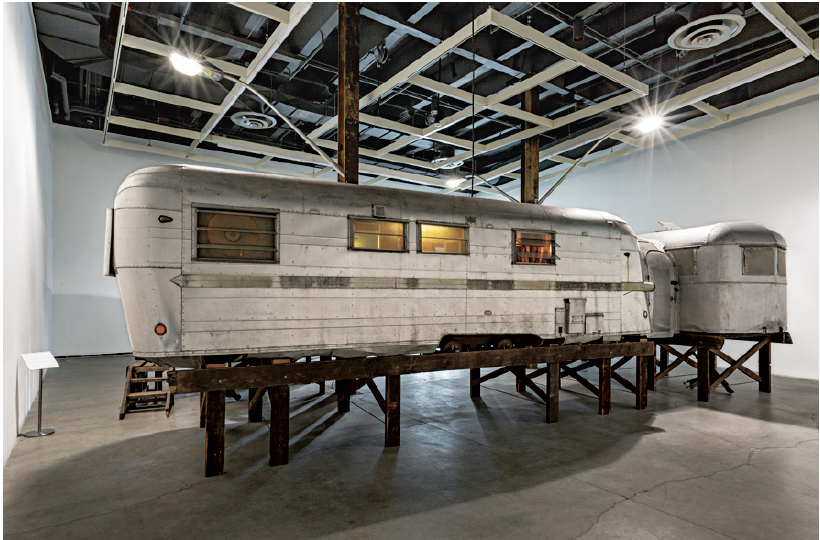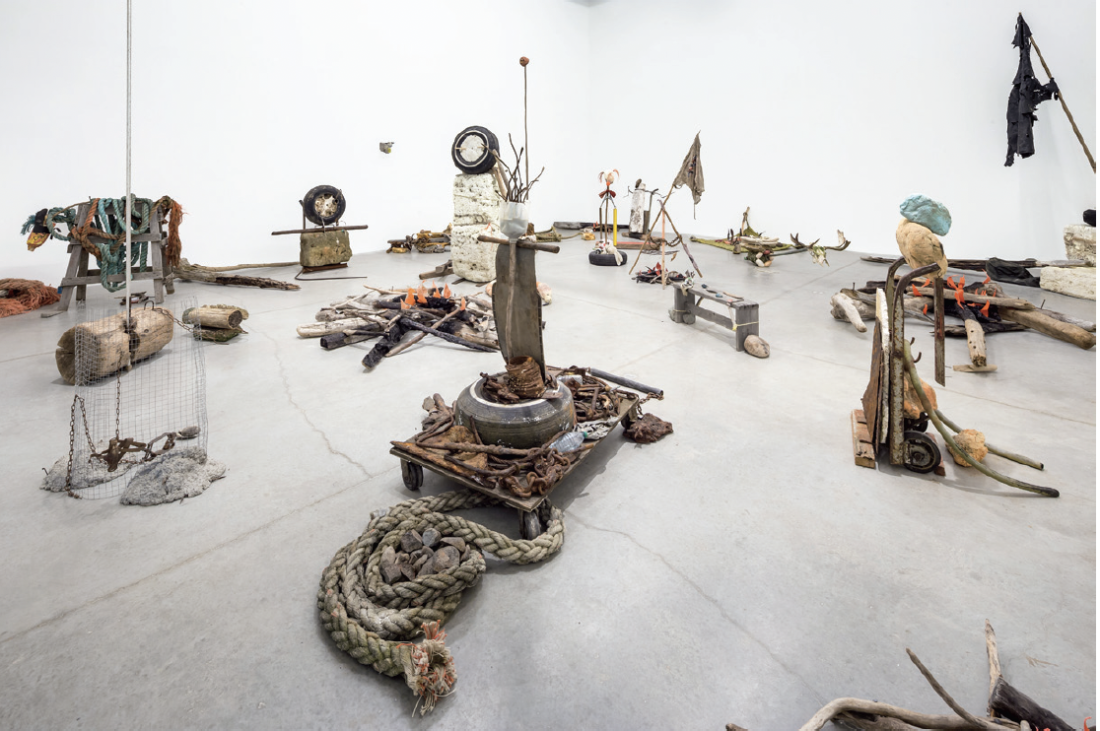Mike Nelson
Memory is too often viewed as the opposite of amnesia. Memory, however, is not complete retention but a grey zone between forgetting and recollection, between accurate recall and imprecise reinterpretation. Mike Nelson considers how clouded memories are suffused through a public gallery site in “Mike Nelson: Amnesiac Hide,” the first Toronto solo exhibition by an artist who was twice shortlisted for the Turner Prize (2001 and 2007) and who represented Britain at the 54th Venice Biennale. A co-presentation with Vancouver’s Contemporary Art Gallery, which mounted its own version in fall 2013, “Amnesiac Hide” at The Power Plant exhibits one previously shown installation (the massive-scale Quiver of Arrows, 2010), and four new commissions facilitated by the CAG, the Walter Phillips Gallery and the Power Plant. Characteristic of Nelson’s work, all five remain unpopulated yet reveal traces of past human presence through sculpture, imagery and text.

Mike Nelson, Quiver of Arrows, 2010, mixed media. Courtesy the artist. Photographs: Toni Hafkenscheid. Courtesy the artist and The Power Plant, Toronto.
Take for instance the dusty belongings of holiday trailer dwellers in Quiver of Arrows. Four rusted, scratched and battered vintage Airstream trailers, their wheels removed, rest atop a crude wooden frame of a square configuration. Viewers navigate cluttered inter-iors, encountering the belongings of former inhabitants—a collection of old cassette tapes, empty Schlitz Tall Boy beer cans, a love note to a guru, drug paraphernalia and garish stoner art, which recounts memories of a hedonistic, nomadic life. With the trailers no longer mobile and their occupants AWOL, this faux-archaeological installation could symbolize the lost gypsy ideals of hippie counterculture; simultaneously, the now rusted shells of the once futuristic Airstreams could symbolize the end of space-age optimism. Whatever led to the departure of this community and when it occurred remains undisclosed, one reason being that Nelson conflates time. He does this by juxtaposing indications of long-term neglect, such as broken glass shards blocking the sink, against clues of a more recent departure, such as a butt-filled ashtray. Memory here writes its own fictions.
The sprawling, jam-packed Gang of Seven more subtly indicates an absent nomadic culture by alluding to a roving biker gang of Nelson’s invention, the Amnesiacs, who have appeared occasionally in his work since 1997. The Amnesiacs share Nelson’s fascination with the beach and the sea, a fascination inspired by Polish sci-fi writer Stanislaw Lem’s novel, Solaris, 1961, in which the sea was an intelligent entity. Accordingly, Nelson collected the materials for the discrete sculptures that make up the Gang of Seven oceanside, along British Columbia’s Strait of Georgia. Rocks, buoys, baseball caps and other detritus adorn plinths and mounts made of cement blocks, tires and pieces of weather-worn wood. A set of deer antlers protruding from a wooden stick resembles motorcycle handlebars—a sculptural gesture perhaps implying the missing bikers are not far away. A makeshift clown face rendered from a plastic bottle and a broken orange ball belies a salvage culture that echoes how Gang of Seven recycles the biker characters Nelson first introduced in a piece titled The Amnesiacs.
Nelson constructed The Amnesiacs when his friend and colleague, Erlend Williamson, an artist and mountaineer, fell to his death on a climb in the Scottish Highlands. Williamson’s ghostly presence manifests itself as a motif in other works, as well. One of these is Eighty Circles through Canada (The Last Possessions of an Orcadian Mountain Man), 2013. Viewers initially face a roughly hewn shelving unit built of recycled wood—again from Vancouver-area beaches. Nelson tells Williamson’s peripatetic biography through an arrangement of his late friend’s material possessions: hiking boots, backpack, old fly fishing reels, camera and photographic prints fill the shelves. Against the back of the shelves, Nelson screens what at first resembles a vacationer’s slide presentation of sublime Rocky Mountain vistas that Nelson photographed on recent road trips in British Columbia and Alberta. Yet this slideshow is not a tourist documentary. He doesn’t focus on the backdrop scenery but on foreground images of campsites, particularly on the rock circles marking fire sites indicated in the title. These stone circles stand as symbolic monuments for the deceased mountaineer, perhaps acting as memory triggers for Nelson when he travelled through the mountains.

Mike Nelson, Gang of Seven, 2013, found materials collected from the North West Pacific Coast.
Williamson’s presence is more directly felt in Double Negative (the Genie), 2014, an installation of seven bulky photocopiers with printed copies encircling them on the floor. The photocopies show Williamson and excerpts from his unfinished travelogue. Pithy words and phrases—“terminus” and “la mort”—clearly broadcast that the installation is funereal. Furthering this atmosphere are the ghostly, grisaille photocopied images and texts themselves. Gradually dissipated hence distanced from the original, they are metaphors for the fading memories of a loved one.
Located prominently in the gallery’s central hall is Untitled (Intimate Sculpture for a Public Space), 2013, the most moving homage to Williamson. A Plexiglas vitrine designed for holding visitors’ cash donations lies horizontally on the floor and exhibits Williamson’s sleeping bag. Gallery-goers can still insert donations to The Power Plant through the requisite cash slot, but the coins spill onto the sleeping bag where the mountaineer’s head would have rested. A corner of the sleeping bag is open as if he still sleeps in it—indeed, one may imagine his head poking out on a cold night. A public gallery site fuses with a private shrine.
Untitled successfully meets the challenge of publicly expressing personal loss so that memories can resonate with gallery viewers. To ensure this connection Mike Nelson wisely intersperses his loss with the communal absence signified by the relics of Quiver of Arrows and Gang of Seven. As well, he blends his memories with Canadian cultural identity in the postcard-pretty landscapes of the Rocky Mountain campsites of Eighty Circles through Canada. In each work disappearance stands alongside recreation in an exhibition that thoughtfully, quietly and poignantly bespeaks how consciousness shifts between reminiscence, amnesia and the present. ❚
Earl Miller is an independent art writer and curator residing in Toronto.
“Mike Nelson: Amnesiac Hide” was exhibited at The Power Plant, Toronto, from February 1 to May 19, 2014.

